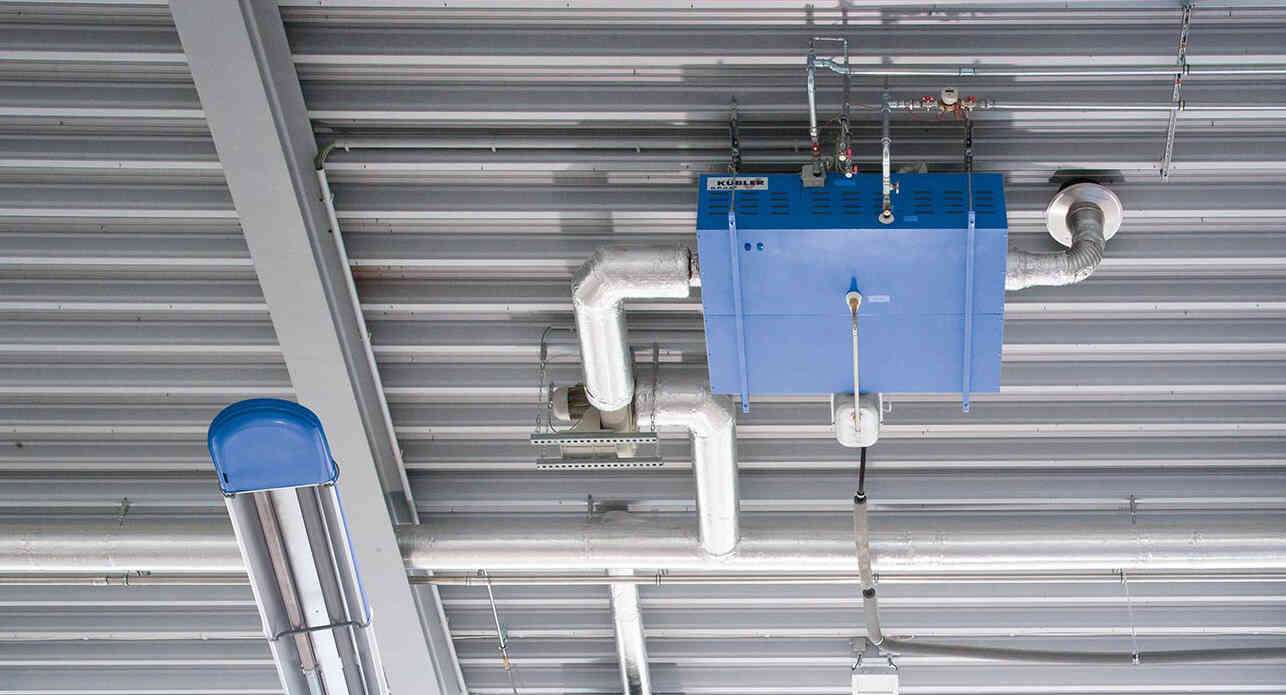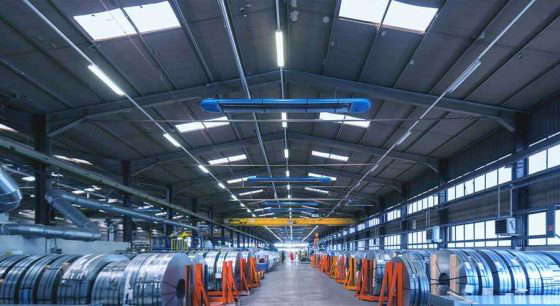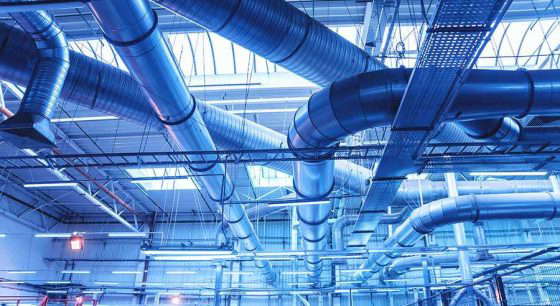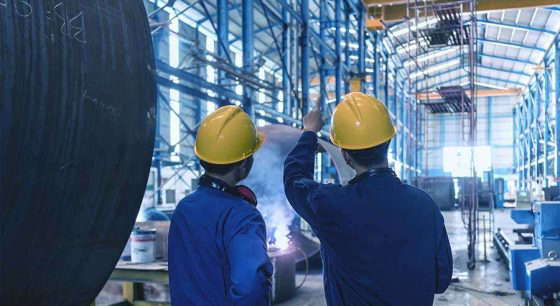Condensing boiler technology makes high savings potential available in companies

Condensing technology converts waste heat into usable energy
The special feature of condensing boiler technology is that it extracts the condensation heat (called calorific value) from the waste heat of heating systems, makes this energy content usable and thus significantly increases the overall efficiency of the systems. Depending on the fuel, this is referred to as oil or gas condensing technology. In short, condensing boiler technology is characterized by the fact that it increases the degree of energy utilization and thus energy efficiency.
How waste heat recovery with condensing boiler technology works
The functional principle of condensing boiler technology is basically very simple. Using infrared heating as an example, the energy contained in the exhaust gas is cooled down to the point of condensation and the heat obtained is transferred to a storage medium (usually water). The heated water is fed to a buffer tank and from there, depending on demand, fed into a standard pumped hot water heating network. Water is ideally suited as a storage medium, but other media such as air can also be used and made usable in hot air blowers, for example.
Start by identifying and reducing your sources of waste heat
It is not only heating systems that generate waste heat; depending on the operating mode, waste heat is generated in a wide variety of places. Ovens, machines (especially air compressors), cooling systems and/or uninsulated pipes are probably the classics. Get to the bottom of the causes of unused waste heat by thoroughly analyzing and evaluating energy consumption throughout the company. It is then important to avoid or at least reduce unnecessary waste heat by optimizing processes. The following questions will help you do this:
- Can you avoid idle time?
- Are all systems/processes really running efficiently, or is there still room for improvement here and there?
- Are some processes perhaps oversized?
- Are there any heating or cooling phases that would not be necessary in practice?
- Do you maintain your machines and systems regularly?
- Are you insulating sufficiently?
With a comprehensive analysis, you can already save a lot of waste heat. And the rest? It's best to use it sensibly, depending on your requirements.
Use the energy gained from condensing boiler technology sensibly
The practical thing about condensing boiler technology is that you can use the waste heat in a variety of ways for greater energy efficiency in your company. "Hybrid heating" is an important keyword here. After all, waste heat can play a major role in hot water preparation or heating rooms. While this variant of waste heat utilization has already established itself in many private households, it is still far from being used everywhere for heating hall buildings. Yet this building segment in particular has a reputation for consuming a lot of energy due to the dimensions of its rooms. There is great potential for savings here. In the industrial sector, for example, the recovered energy can be used for domestic hot water or for hot water-based (hybrid) heating. This often makes sense for offices or social rooms, which are typically connected to halls. In the sports sector, hot water is often used in sanitary facilities, especially for shower rooms. Where appropriate, hot air can be used via hot air blowers to supplement energy-efficient infrared heating.
Bundle your energy flows for greater energy efficiency
Not only the waste heat from heating systems can be harnessed, numerous other heat flows in the hall building also offer interesting, efficiency-enhancing potential. Namely when you intelligently combine condensing boiler technology and heating. One example is the H.Y.B.R.I.D. infrared heating system from the Ludwigshafen-based hall heating specialist KÜBLER. The fully integrated solution offers great flexibility in the integration of different technologies and energy sources. For example, the hybrid system can utilize the energy flows from the process (machines, compressors, etc.) at the same time as the waste heat from the heating system. At a textile machinery manufacturer from North Rhine-Westphalia, the energy flows from the heating system, curing ovens and compressors were combined in this way. Since then, the heat requirement of 1,200 m² of office space can be completely covered by the residual heat utilization.
There are also numerous other possible combinations. What is particularly interesting in view of the usually large roof areas of industrial halls is that the hybrid system, which has won several awards (including "Germany's most sustainable product", German Sustainability Award 2012), can also integrate renewable energies such as solar thermal energy (keyword: Helio.B.R.I.D.). Heat pumps can also be integrated. In addition, the hybrid system is the basis for the implementation of digital hall heating (e.g. WÄRME 4.0), which makes it possible, among other things, to continuously run the system on an ideal line through real-time monitoring of current consumption. The combination of condensing boiler technology and energy-saving heating technology therefore allows you to ensure greater energy efficiency in your company in a variety of ways.
Why you should focus on your company and climate targets at the same time
Only around half of German companies are aware of their waste heat potential - as dena writes in its publication on waste heat utilization as part of the EnergyEfficiency Initiative2 . Somit gehen jedes Jahr schätzungsweise 226 TWh nutzbare Wärme ungenutzt flöten. Das sind 36 % des Energieanteils des gesamten produzierenden Gewerbes. Unternehmen kostet das – ganz klar – immens viel Geld, doch gleichzeitig belastet die ungenutzte Abwärme die Umwelt. Rund 60 Mio. t des Treibhausgases CO₂ verdampfen damit pro Jahr unnötig in die Atmosphäre. Unternehmen können und wollen sich das heutzutage im Hinblick auf steigende Energiekosten und Klimaschutzziele einfach nicht mehr erlauben.
Make environmental protection your profitability measure
Dass die Abwärmenutzung mit Brennwerttechnik nahezu ohne zusätzliche Verbrauchskosten geschieht, dürfte viele Hallenbetreiber sehr interessieren. Insgesamt können durch die integrierte KÜBLER Restwärmenutzung im Hybridsystem bis zu 15 Prozent Wärme zurück gewonnen und nutzbar gemacht werden. Thomas Kübler, Gründer und geschäftsführender Gesellschafter der KÜBLER GmbH Energiesparende Hallenheizungen: „Diese Zahl zusätzlich zu unseren ohnehin extrem energieeffizienten Infrarotsystemen markiert einen Quantensprung in der wirtschaftlichen und umweltschonenden Hallenbeheizung. Im Gesamtsystem lassen sich bis zu 70 Prozent* Energieeinsparung realisieren.“
* Compared to conventional technologies
How the combination of condensing boiler technology and IR heating pays off in practice
Wie sich diese Werte konkret für Hallenbetreiber auszahlen, zeigen Beispiele aus der Praxis. Um rund 65 % wurden die CO₂-Emissionen durch die Heizungsmodernisierung mit dem KÜBLER System H.Y.B.R.I.D. in einer Fertigungshalle der Firmengruppe AZO in Osterburken reduziert. Konkret von ca. 226.400 kg p. a. auf jährlich ca. 79.800 kg. Mehr Energieeffizienz stand auch im Mittelpunkt bei Reiners + Fürst. Ebenfalls rund 65 % hoch waren die Energieeinsparungen, die der Textilmaschinenbauer bei der energetischen Sanierung seiner Produktions- und Lagerflächen realisieren konnte. Die Einsparungen belaufen sich hier konkret auf rund 46.500 Euro und 299 t CO₂-Emissionen pro Jahr. Übrigens: Reiners + Fürst wurde für die Sanierung der Hallenheizung und die Integration von Restwärmenutzung bei Hallenheizung, Druckluft und Härteofen im System H.Y.B.R.I.D. 2014 mit dem 1. Platz beim Energy Masters Award in der Kategorie Gebäude ausgezeichnet.
The bottom line: hybrid heating with condensing boiler technology pays off - especially financially!
Using less energy to generate heat saves money. That is crystal clear. How this translates into concrete figures depends on various factors, such as
- Type and size of your company
- The volume to be heated
- The number of processes that generate waste heat
- The heating you use
Conclusion: Optimization potential can be found in many different places
Hall modernization, proper insulation, highly efficient heating systems, condensing boiler technology and other options for modern waste heat recovery: there are many ways to increase the energy efficiency of your business and reduce costs. Feel free to contact us and let us discuss how you can use the waste heat from your heating and production processes sensibly instead of disposing of it unused through the chimney.
1 Weblink: https://www.dena.de/themen-projekte/energieeffizienz/
2 Cf. 1445_Brochure_Utilization_of_Waste_Heat.pdf (dena.de)
-
Infrared hall heating in your production: How to create the right indoor climate for your productionIndoor buildings are a world of their own. Especially in winter. The high rooms pose a real challenge for anyone who wants to ensure the most pleasant working climate possible. But there are solutions - infrared hall heating, for example.
-
What is probably the most effective lever against the gas crisis, price pressure and dependence on Russia at the moment? The answer: consuming less energy. The German government is of this opinion and is calling for energy savings in a large-scale campaign - supported by industry and associations. This goal can be achieved. When it comes to the large halls of industrial and commercial enterprises, it is even easier and quicker than expected.
-
Only around half of German companies are aware of their waste heat potential - as dena writes in its publication on waste heat utilization as part of the Energy Efficiency Initiative. This means that an estimated 226 TWh of usable heat goes unused every year. That is 36 % of the energy used by the entire manufacturing industry. This clearly costs companies an enormous amount of money, but at the same time the unused waste heat has a negative impact on the environment. Around 60 million tons of the greenhouse gas CO₂ evaporate unnecessarily into the atmosphere every year. In view of rising energy costs and climate protection targets, companies simply can no longer afford to do this.
-
Operators of indoor heating systems are also responsible for having their system serviced regularly. In addition to operational safety, there are other good reasons why maintenance should not be put on the back burner!





